May 9, 2012
And why pray tell should Harriet be invited to join our group?
 This is perfect. Thanks to Patricia for the link!
This is perfect. Thanks to Patricia for the link!
May 9, 2012
The Vicious Circle reads My Life in France by Julia Child
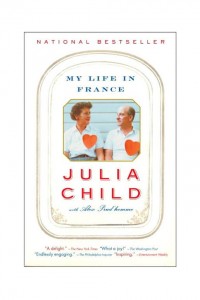 On Monday night, we assembled in Brockton Village for some French fare– quiche, excellent wine, truffles, profiteroles, and the cake from Bringing Up Bebe. Our book was Julia Child’s My Life in France, which was our first foray into autobiography, and which everybody liked, which was very unusual. And even more unusual– even though everybody liked it, we had plenty to talk about.
On Monday night, we assembled in Brockton Village for some French fare– quiche, excellent wine, truffles, profiteroles, and the cake from Bringing Up Bebe. Our book was Julia Child’s My Life in France, which was our first foray into autobiography, and which everybody liked, which was very unusual. And even more unusual– even though everybody liked it, we had plenty to talk about.
In general, we found the book delightful. There was speculation as to the nature of Julia and Paul’s romance, as to the lipstick on his belly-button. It was supposed that they’d had “a delicious sex life”, though we wondered how to rectify that with rumours that both were actually gay. And here is the thing with biography, especially auto– how fast we stop thinking about the book itself and instead become intent on the people within it.
But that’s kind of the point– we were fascinated by Child’s restraint, her control, by what is held back in her autobiography and what is revealed. How she dares to say that she hadn’t cared for her father, that she was glad when he died. Later on, she notes that she’s not a sentimental person, and we note that this is an understatement. Like Edith Piaf, who seems to be the one person Julia Child didn’t attend dinner parties with during her years in Paris (although she was Matron of Honour at Bumby Hemingway’s wedding to Puck Whitlock), Child regretted nothing, and this is a character trait that is as admirable as it is troubling and intriguing. (Also, none of us were fully convinced by it. We were sure that beneath the narrative, there was so much more going on.)
We were fascinated that the story begins when she is older, in her late ’30s, a late bloomer– what a different story this would have been had Julia Child not gone to Paris in her prime. We wonder what she was doing in the years before her story starts– yes, there was the war, but otherwise, apparently, she was up to not much. And once again, we speculate that something is being obscured. We wonder at her complete lack of emotional trauma. Though we note that she does get her digs in– she just lets her husband do the dirty work, and here we’re talking about the terrible things she lets through that he says about Simca. Her restraint is certainly not entire.
We talked about Saving Rome, a book we read last Fall, which divided us in its depiction of expatriate life. At one point, Child runs into an old friend in Paris who is as fed up with the expat thing as Megan Williams’ character had been, and Child confesses herself to be baffled by this response to Parisian life. And it’s true that Child’s take on Paris is what some of felt was missing from Williams’ book, the enthusiasm, willingness to learn and explore. But then we concede that Julia Child was a very unusual person, and the Saving Rome characters are probably more the norm.
We note that Child’s sense of adventure was never stymied, that she viewed challenge as an opportunity. That after two decades of drifting that she was so glad to find her place in the world, her path in life. That she had an unusual amount of freedom accorded by inherited wealth, but also by her extraordinary marriage. That in some many ways, her husband was her wife, and that she never fulfilled for him the role of the diplomatic wife, but this never seemed to bother either of them.
Something about the narrative grated though, however much it was delightful. That there was no depth, no variance in tone. Can one person be so perpetually buoyant? There is such distance between writer and reader and we wonder where it comes from– is it her disposition? The co-author showing his hand? We note the peculiar structure of the book itself, that it does not reach for depths. It is to be a book about “things I loved in my life.” It is to document a world that is almost gone, in terms of her own life and the food culture she came to know in France. We talked about the resources available to her in reconstructing her history– her husband’s extraordinary letters home to his brother, and also his photographs. Anyway, this is a book about vignettes. They’re meant to be sketchy. But the distance still means that we find them “sketchy” in another sense.
Anyway, she wasn’t a memoirist, but a cookbook writer. Though there was nothing lacking in her narrative here, or at least unintentionally. She knew what she doing, but why did she do it this way? We remark upon the fact that Julia Child was a very strange woman, 6″2, and that voice. This leads to more talk of her sex life again. We note that she seemed more upset at leaving her house in France than at putting her husband in a home. She writes of certain individuals who “weren’t intellectuals.” We wonder where she gets off with these judgments, and then realize that she didn’t consider her own self an intellectual either, and it is one of the instances where she is self-critical. She resents her inability to hold her own in political discussions, and it’s an ongoing project in her life to do this better.
We talk about the book’s cover– the schlocky picture on the front which makes more sense when you realize that Paul and Julia made such pictures for their Valentines cards every year. And some of us have the movie tie-in version, which is less appealing, and Meryl Streep all over the place. We talk about the movie, and how it was surprisingly charming, and we have strong opinions about Julie Powell. Though she can write, it is admitted. And then talk turns to lesser bloggers-turned-writers.
And before the talk of other things totally takes over, we remark upon how much Julia Child has to say about the publishing industry, about how much it as been falling apart in the same old ways for years and years and years. That she also had issues with and ideas about self-promotion, which is interesting because this self-promotion is meant to be a fairly modern phenomenon. Her editor Judith Jones was behind the publication of The Diary of Anne Frank in America, and we’re bothered that in Child’s book, Anne Frank’s name is misspelled without an “e”. It’s the only typo in the book that we could see, but a glaring one. And in other mistakes, we’re thinking about how the first version of her book advised baking French bread on a slab of asbestos tile, but it was righted in the end. We loved Child’s approach to life– never stop learning and don’t apologize.
May 8, 2012
Almost There by Curtis Gillespie
 “Happy families are not the most fertile writerly soil, for as Tolstoy so famously wrote in Anna Karenina, ‘Happy families are all alike; every unhappy family is unhappy in its own way.’ But if I can be so presumptuous as to reframe Tolstoy’s words, I would say that every happy family will vacation in its own unique way, whereas unhappy families are all alike on vacation.” –Curtis Gillespie
“Happy families are not the most fertile writerly soil, for as Tolstoy so famously wrote in Anna Karenina, ‘Happy families are all alike; every unhappy family is unhappy in its own way.’ But if I can be so presumptuous as to reframe Tolstoy’s words, I would say that every happy family will vacation in its own unique way, whereas unhappy families are all alike on vacation.” –Curtis Gillespie
There was the trip to the east coast when I was ten, when the floor of the backseat was so packed with toys that we could only sit cross-legged. Memories include the jellyfish sting in New Brunswick, being buried in the sand in Ingonish, lobster dinners, the Sandspit Amusement Park in Cavendish, too much mini-golf, and winning a free supper someplace with my rendition of “Free to be you and me.” The west coast was six years later, and I remember less because by then I was a sullen teen scouring small towns for payphones from which I could call my boyfriend, but I remember Banff with my sister (who would, a decade later, decide to call the place home), disgusting roadside bathrooms, swimming in the freezing cold Alice Lake, how beautiful was Victoria, and goats on a rooftop on Nanaimo. And before and after and in between, there were summers at the cottage, drives to Florida, boat rides through the Thousand Islands, road trips all over Ontario, and unfortunate March Break when money was a bit short and we resorted to making Kitchener our destination.
So yes, I agreed with Gillespie’s thesis entirely in Almost There: The Family Vacation Then and Now that our family vacations are the means by we get a sense of who we are as a family, of what “family” is. He writes, “The family vacation is a way to bank family memories, to colour in what might otherwise be broad outlines.” His book is a mix of those memories, of his childhood family vacations and vacations now with a family of his own, with broader historical and sociological research in regards to the family vacation. Which, academically speaking, remains an unexamined field of study– the family vacation itself is a very modern institution.
It begins, Gillespie tells us, with the advent of leisure time, to paid holidays and weekends. And, he notes in his first chapter, with the widespread use of the automobile that suddenly made “getting there” not only an attainable goal, but also part of the adventure. From the history of the road trip, he moves on to camping and cottaging: “Returning to a favoured place, owned or not, is a key and appealing aspect of the cottage ritual, and therefore becomes a central part of our memory making… The ritualized and repetitive nature of such holidays becomes a measuring tool…” His observations regarding camping– that we’re looking for a manufactured form of adventure– become even more pertinent in his chapter on cruises, then Disney destinations, and RVs. (Gillespie writes, “But it seems to me that if the point of having a luxury RV is to take your home with you, then why don’t you just stay home?”). And what is the future of the vacation? Gillespie fears that our children are being entertained to death, losing the vital skill of being able to pass hours on a car journey whilst staring at the window, which is the kind of experience that opens the mind up so wide (and what vacations are about in the first place).
Gillespie’s anecdotes throughout the book are funny, the first and final ones horrifyingly so. His parents and five siblings took advantage of their station wagon’s jump-seats and partook in an epic drive from Alberta to Mexico City whose highlights are the highlight of this book also. Later on, the family got serious and bought themselves a converted bus, which they eventually decided to sell due to its dubious propane stove. He recounts also a harrowing trip down a hill in Australia behind the wheel of an RV, his terrified family behind him, also how they all barely survived a hot air balloon ride, and the time his daughter tried to take off his pants at a public reading during the summer they spent in France.
It must have broken Gillespie’s heart to discover that the very best title ever for a book like this was already taken– Are We There Yet? was published in 2008. And though he demonstrates that he’s familiar with that book and others in the same field, even though his research in general was impressively extensive, I came away with a sense that his material was still unprocessed. The anecdotes were hilarious, the trivia was fascinating, but what it culminated in failed to leave a great impression. At times, even Gillespie seemed aware of the lack of momentum in his narrative, as ideas kept being rephrased and re-framed, as he would backtrack to undermine his own points or ideas, many instances or “as I’ve already said” or “…but we’ll get to that in a moment.”
Though in a way it’s a fitting structure for a book about the vacation, the journey being the point after all, and the diversions, the surprises. For a book that calls itself Almost There, and so it is, but the trip is still memorable.
May 8, 2012
On Maurice Sendak
 The other day I was talking about friends of ours and said, “They didn’t have a party when he turned one,” to which Harriet responded, “His immediately family frowned on fun.” Which isn’t technically true, but is a testament to how our favourite books reside so centrally in our consciousnesses, even after the books are closed,that she could so reference Maurice Sendak’s Bumble Ardy off the cuff.
The other day I was talking about friends of ours and said, “They didn’t have a party when he turned one,” to which Harriet responded, “His immediately family frowned on fun.” Which isn’t technically true, but is a testament to how our favourite books reside so centrally in our consciousnesses, even after the books are closed,that she could so reference Maurice Sendak’s Bumble Ardy off the cuff.
Maurice Sendak died today at the age of 82. I didn’t read a lot of him when I was little, apart from Where the Wild Things Are, but I didn’t even read that one enough to properly probe its depths. Truth be told, I still don’t properly get Maurice Sendak, which sometimes annoys me, and certainly makes me uncomfortable, but it’s also the reason why his work fascinates me so much. His stories are either everything or nothing, and depending upon what mood I’m in, my perspective changes all the time.
When I first read Outside Over There though, I started to get a sense of how much is going on in his work underneath the surface, even if the action itself is not altogether accessible to me. That book is so weird, and I’ve read it a million times, and I still don’t really understand it, but I suspect that the text is as detailed and full of allusions as the illustrations are. It’s a mystery that I’ll be unravelling forever. It’s much easier to out-and-out love The Night Kitchen, though in some ways that book is even weirder, but I love the almost rhymes and the box cityscape. I want to always have cake in the morning too. Cock a doodle doo. And then yes, Wild Things, the most graspable of the three and I love its run-on sentences, and I love the wild rumpus just like everyone. I also love the line, “Please don’t go. We’ll eat you up. We love you so.” Life is complicated. 
More straightforward is how much we love Maurice Sendak’s illustrations– Little Bear is so absolutely wonderful. I also really love Chicken Soup With Rice, which dares to boil a pot at the bottom of the sea. And his latest book, Bumble Ardy, which we bought last Fall and whose weirdness Harriet has never even raised an eyebrow at yet. Because she’s still little enough to take the world as she finds it, and how much richer is she (and all of us) for Maurice Sendak’s work being in it.
May 6, 2012
Author Interviews at Pickle Me This: Heather Birrell
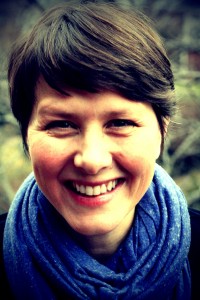 In February 2008, I spent one of the most perfect days of my entire life sitting on the grass in San Francisco’s Dolores Park, reading the journal Hobart in Canada/America, which I’d purchased the day before at the legendary City Lights Bookstore. And it was in that journal that I first encountered the work of Heather Birrell with the short story “My Friend Taisie”. Later on the next year, Heather turned up in the also-legendary “Salon de Refuses” issue of The New Quarterly, and I made a note on my blog that her story “Impossible to Die In Your Dreams” had been my favourite of the collection. (I also attended a panel discussion about the Salon of which Heather was a part. You can go here to see amusing pictures of Stuart and I looking extraordinarily bored).
In February 2008, I spent one of the most perfect days of my entire life sitting on the grass in San Francisco’s Dolores Park, reading the journal Hobart in Canada/America, which I’d purchased the day before at the legendary City Lights Bookstore. And it was in that journal that I first encountered the work of Heather Birrell with the short story “My Friend Taisie”. Later on the next year, Heather turned up in the also-legendary “Salon de Refuses” issue of The New Quarterly, and I made a note on my blog that her story “Impossible to Die In Your Dreams” had been my favourite of the collection. (I also attended a panel discussion about the Salon of which Heather was a part. You can go here to see amusing pictures of Stuart and I looking extraordinarily bored).
Heather emailed me after I’d mentioned her work on my blog. At the time she had a newborn daughter, and I was newly pregnant, and of motherhood she advised me: “time does shrivel, but it also expands in marvellous ways.” Which was true, but also a very kind lesson in restraint, I note in retrospect. Heather and I finally met in person in Kathryn Kuitenbrouwer’s kitchen one day about two years ago, and I’ve adored her steadily ever since.
Heather Birrell is the author of the story collections Mad Hope and I know you are but what am I? Her work has been honoured with the Journey Prize for short fiction and the Edna Staebler Award for creative non-fiction, and has been shortlisted for both National and Western Magazine Awards. Birrell’s stories have appeared in many North American journals and anthologies, including Prism International, The New Quarterly, Descant, Matrix and Toronto Noir. She lives in Toronto with her husband and two daughters where she also teaches high school English.
Heather’s new book Mad Hope is mind-blowingly excellent. She very kindly answered my questions via email throughout this past April, beginning on a very sunny Easter weekend when both of us were ill.
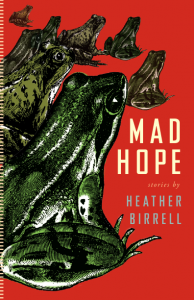 I: “Where do you get your ideas” is a profoundly uninteresting question, but I want to come at it from a different angle. As I’m reading Mad Hope, I keep encountering these moments of profound identification where I want to write “Exactly” in the margins and underline it twice. And it’s for really oddly specific details, like the expressionless Iranian midwife, or following up a trip to the abortion clinic with Swiss Chalet. Or Jordan’s gait: “His hip dipped and his arm swung like a creature who had chosen– righteously– to remain less evolved.”
I: “Where do you get your ideas” is a profoundly uninteresting question, but I want to come at it from a different angle. As I’m reading Mad Hope, I keep encountering these moments of profound identification where I want to write “Exactly” in the margins and underline it twice. And it’s for really oddly specific details, like the expressionless Iranian midwife, or following up a trip to the abortion clinic with Swiss Chalet. Or Jordan’s gait: “His hip dipped and his arm swung like a creature who had chosen– righteously– to remain less evolved.”
And I know exactly who or what you’re talking about. I’ve probably even seen it, or read it– your stories also reference magazine articles I’ve encountered, email-forwards I was receiving as recently as last summer. Part of it is because so often you’re writing about– and so effectively too– the very city I live in, so of course I find it all familiar. But I’m still intrigued by how you employ the stuff of the world in your fiction, by your command of the material. And am I right to suppose that this very stuff– email forwards, post-abortion dipping sauces– is where you get your ideas from? Can you talk about your process?
HB: Oh, I’m so glad you had the ‘Exactly’ reaction! I love that sensation of somehow being known by the author as I read. I think those descriptions, expressions, shards of ‘true’ story you reference definitely serve as starting points for me but they don’t mean much until I’ve actually got some kind of more amorphous/abstract driving force in mind. Annie Dillard talks about ‘writing your own astonishment’ — I love that. There is such a range of issues, incidents, images that have the power to astonish — and they are different for everyone. I tend to think of my astonishments in the same way I might consider arguments if I were writing an essay — in other words, there’s something I’m trying not to prove but perhaps to convey in the best possible way, but my tools are less logical than metaphorical, narratorial.
In the story ‘Drowning…’ I wanted badly to write about suffocating mother-love, how the weight of mothering can be crushing at times… Then there were other bits and pieces preoccupying me: the time my husband nearly died of an asthma attack; an article I read about sole survivors of terrible catastrophes — that loneliness; what it means to teach kids with backgrounds very different from my own; and the email forward of the title of course! (This all sounds quite autobiographical, doesn’t it? But it isn’t always, and I’m not sure it even is here.)
So all these disparate threads, all these astonishments, somehow came together… How? I’m not being coy when I say I’m not really certain. It really does often feel that once a story is finished or near-finished I wiggle out of it like an old skin and it feels quite separate– an artifact unrelated to me.
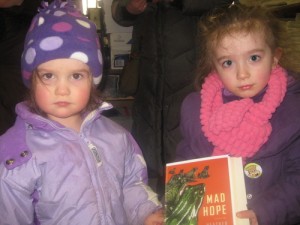 I: These stories give the sense that you must read a lot, and widely. I could be wrong, but then I can’t imagine any way but reading for someone to learn, to know, as much about the world as your stories seem to convey you do. You mention elements of the autobiographical, yes, and I also see startling powers of observation at work (in particular in your portrayal of teenagers), but mostly Mad Hope seems to be the work of an author who reads widely. Is that true? What is the connection between your reading and your writing? What do you like to read?
I: These stories give the sense that you must read a lot, and widely. I could be wrong, but then I can’t imagine any way but reading for someone to learn, to know, as much about the world as your stories seem to convey you do. You mention elements of the autobiographical, yes, and I also see startling powers of observation at work (in particular in your portrayal of teenagers), but mostly Mad Hope seems to be the work of an author who reads widely. Is that true? What is the connection between your reading and your writing? What do you like to read?
HB: I am a reader, I am a reader, she intones quietly to herself. It has seemed for so long that my reading habits have been patchy and piecemeal. I have two small children; my sleep has been ragged for the last four years, so I suppose I have become more discriminating in some ways, but also hungry for narrative in any form as a means of escape from the more mundane aspects of motherhood. Because I often read in snatches, periodicals have been perfect lately — so I’ve been reading a lot of The New Yorker and The New Quarterly, and recently Brain, Child (which I discovered through your blog) — and big fat page turners that can be picked up, put down, and easily abandoned if need be.
Having said that, there are writers I return to (writers I could never abandon), writers I think of as unofficial mentors. Deborah Eisenberg. I adore her writing– it’s intricate, it’s smart, it’s funny, it’s city, it’s political. And her stories are long, which is more my rhythm when it comes to story reading and making. I tend to gravitate towards stories whose narrators are crouched in close to their characters, whose characters are complex, layered. I like unconventional story shapes too– stories that bulge out of themselves a little bit. Alice Munro, because her stories are masterful and mysterious. Anne Enright is a more recent discovery. I loved The Gathering, a novel that reads like a short story, and The Forgotten Waltz and her fabulous memoir Making Babies: Stumbling into Motherhood. Mary Gaitskill’s most recent collection, Don’t Cry, blew me away. It is so very fierce and wise. I find reading all of these writers incredibly permission-giving — ‘You can do that?’ they make me exclaim. It’s a wonderful and daunting feeling to have as a writer, to have the gauntlet thrown down in that way…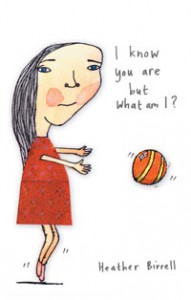
I am also incredibly inspired by the filmmaker Mike Leigh. I love how he manages moments of connection between his characters. His is a kitchen sink realism that recognizes the gritty, grimy, but also the gleaming moments that occur between people. And he does family dynamics — the secrets, the sadness, the omissions, the overwhelming love and sense of duty, the guilt, the fun, the fatigue — so very well. The way he builds to peaks of drama is so subtle and genuine — it’s really impressive. I also find him a very ‘moral’ artist, for want of a better term. He has such integrity, and his convictions are so present in his work but he is very seldom didactic. I think he’s a genius.
I: With what would you recommend your readers follow up Mad Hope? This is not a rhetorical question. In fact, this isn’t even really an interview question. But all I know is that I finished your book last weekend and the two short story collections I’ve read since (Other People We Married by Emma Straub and The Girl in the Flammable Skirt by Aimee Bender) have paled in comparison. Have you ruined reading for me, Heather Birrell? What would you advise me to do? (And I promise, we’re going to get back to talking about your book with the next question. Or that’s the plan, at least.)
HB: You are kind. And too smart and voracious a reader to be stymied by the likes of me. I’m pretty picky with short story collections now. I know what I like and don’t have a lot of patience for what I don’t. Plus I really do like to feel challenged. Jim Shepard’s Like You’d Understand Anyway is pretty great — the man goes to crazy, faraway places in his fiction and creates amazingly authentic worlds. And Amy Bloom’s Where the God of Love Hangs Out is the work of a writer who really understands people and acknowledges their mystery. She’s a taboo buster too, which I like. So I would advise you to have a cup a tea and a scone and keep on truckin’, Ms Kerry Clare.
 I: I want to talk about your story ‘No One Else Really Wants to Listen’, which is structured as a series of posts on an online pregnancy forum. And the structure is so interesting because it allows for such a variety of points of view, believable absurdity and for clashes between characters that would happen nowhere else in the actual world. One of your characters writes, “And as for the internet—we have both been busy with it.” Do you think the internet and online forms of communication represent similar opportunity for writers using it in their fiction? What’s its potential?
I: I want to talk about your story ‘No One Else Really Wants to Listen’, which is structured as a series of posts on an online pregnancy forum. And the structure is so interesting because it allows for such a variety of points of view, believable absurdity and for clashes between characters that would happen nowhere else in the actual world. One of your characters writes, “And as for the internet—we have both been busy with it.” Do you think the internet and online forms of communication represent similar opportunity for writers using it in their fiction? What’s its potential?
HB: Short answer: Yes. People talk to each other through e-mail, online forums, texting, tweeting. And writers have always been interested in how we talk to and at each other. Having said that, the story you’re referring to didn’t start out as a ‘pregnancy forum’ story. One of the characters, Wings, arrived pretty fully formed on the page, and I wasn’t really sure what to do with her. She’s kind of obnoxious and over-the-top and I felt she needed someone or something to temper her in some way. At the time, I had been experimenting with using multiple points-of-view in my stories and simultaneously reading a lot of pregnancy/baby forums, so adding these voices seemed like a natural move. But it took me a while — and the nudging of my editor — to figure out that I didn’t have to represent everyone in my story just because everyone showed up in a free-for-all forum. I had to locate the story in the cacophony and then winnow it down a bit. And we decided we didn’t want the story to be too cluttered up by some of the formatting you find online — that in the end, it was the words that were important. But you’re right that the potential of this form is that it brings together people (characters) who might not otherwise meet, and that is terribly exciting.
As for the possibilities of the internet as a story making and delivery system — I think they are myriad. There are opportunities for a loose and nimble kind of creation — pass the story type stuff — online workshopping, and of course more traditional online publishing (Joyland). And there are apps out there right now, I’m thinking of Storyville in particular, that will deliver stories to your device in very readable formats. And I’m sure the possibilities will only increase as the technology changes and people change and grow with it. (I will confess here that my engagement with technology is sometimes reluctant, and I can only create new work using old school pen and paper. I think the world of the internets can be difficult to navigate and there are times I need to completely disengage from it in order to maintain any semblance of personal equilibrium.) (more…)
May 3, 2012
Our Best Book of the Library Haul: Katy the Caboose Who Got Loose by Bill Peet
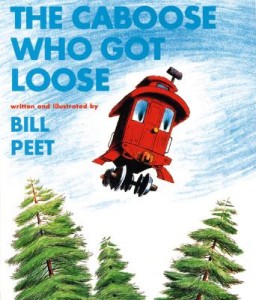 I’m sure I’m not the only person who has read this book at least twice daily all week long, but still, the experience has granted me a certain authority to say that it’s one of the finest train books out there– even better than Virginia Lee Burton’s Choo Choo and Don Freeman’s Chuggy. The Caboose Who Got Loose by Bill Peet is about a delightful red caboose called Katy who longs for quiet and stability, for the end of a life of rumbling, smoke, and dark tunnels. Her wish comes true in the most surprising way, but not until the very end of the story. Before it does, there is plenty of train track adventures, rumbling through field and town, passing houses with faces as charming as Katy’s own, and perilous pulls around mountain ledges. Our resident train fiend loved this one, and I did too, mostly because I’m a sucker for rhyming couplets every time. If there is a book I have to read twice daily for a week, it always goes down so much better in verse.
I’m sure I’m not the only person who has read this book at least twice daily all week long, but still, the experience has granted me a certain authority to say that it’s one of the finest train books out there– even better than Virginia Lee Burton’s Choo Choo and Don Freeman’s Chuggy. The Caboose Who Got Loose by Bill Peet is about a delightful red caboose called Katy who longs for quiet and stability, for the end of a life of rumbling, smoke, and dark tunnels. Her wish comes true in the most surprising way, but not until the very end of the story. Before it does, there is plenty of train track adventures, rumbling through field and town, passing houses with faces as charming as Katy’s own, and perilous pulls around mountain ledges. Our resident train fiend loved this one, and I did too, mostly because I’m a sucker for rhyming couplets every time. If there is a book I have to read twice daily for a week, it always goes down so much better in verse.
May 1, 2012
Mennonites Don't Dance by Darcie Friesen Hossack
 I overcame my fear of prairie fiction to pick up Darcie Friesen Hossack’s Mennonites Don’t Dance, which was nominated for the 2011 Commonwealth Writers Prize for First Book, was also a 2011 Globe and Mail Best First Fiction Selection, and nominated for the Danuta Gleed Literary Award. And I came away from this book hungry. Hossack’s bio lists her as a long-time food writer, and her cred comes through in this collection with its evocative descriptions of Mennonite fare– rollkuchen, varenyky, fresh baked bread, and pies, even the thin ones. (“No wonder we’re all as fat cheese,” a character at one point says.)
I overcame my fear of prairie fiction to pick up Darcie Friesen Hossack’s Mennonites Don’t Dance, which was nominated for the 2011 Commonwealth Writers Prize for First Book, was also a 2011 Globe and Mail Best First Fiction Selection, and nominated for the Danuta Gleed Literary Award. And I came away from this book hungry. Hossack’s bio lists her as a long-time food writer, and her cred comes through in this collection with its evocative descriptions of Mennonite fare– rollkuchen, varenyky, fresh baked bread, and pies, even the thin ones. (“No wonder we’re all as fat cheese,” a character at one point says.)
Mennonites may not dance, but through these stories Hossack shows that their lives take place on the full spectrum of human experience. Demons are fought, temptations succumbed to, secrets are kept and revealed, a cache of dandelion wine hidden, and characters carry history like an awkward burden that refuses to be shed. The great strength of these stories is the complexity of their people, who struggle between impulses and are most human in their tendencies to choose the path of least resistance. So that the mother or father who has every intention of learning from their own parents’ mistakes finds his or herself falling into the same old patterns worn like grooves in a dusty road.
The stories fall down in their dialogue, however, which never flows as naturally as the rest of the prose, and seems stilted and obvious delivered from characters who are shown to have such rich inner lives. It’s the one indication that this book is a first book, because otherwise, the reader can get entirely lost in the remarkable textures of these stories. In “Luna”, Hossack telescopes time, showing Jonah from boy to man, struggling to be a better man than his father was but finding it easier to forget the lessons his childhood taught him, to carry on a family legacy of anger and bitterness, casting off the reasons he was always sure he wouldn’t. In “Ashes”, a daughter-in-law’s miscarriage opens a mother’s old wound, and fosters a connection between the women for the very first time. In the story “Little Lamb”, which was shortlisted for the Journey Prize, a sensitive boy is toughened up for farm life, steeled with the same hardness we see other characters carry through their lives and how much it is a construction. This story is impressively narrated by the boy’s older brother who has seen it all before. “Dandelion Wine” and “Loft” are also told from the perspective of siblings acting as an awkward juncture between a parent and child’s fraught relationship, pulled by dividing loyalties.
The long story “Mennonites Don’t Dance” shows the disconnect between generations and family members. When Lizbeth’s brother is murdered by redneck neighbours, she views her parents’ passivity in the face of the tragedy as a failure and begins a retreat away from history and tradition, but one so far that she becomes stranded. She is saved by her mother, however, which puts this story apart from others in which parents (burdened by the same hardness as necessitated in “Little Lamb”) are unable and unwilling to catch their children when fall, and also who persist in pushing their children away from them. And I like how the generational breaks here are a two-way street– Hossack’s parent characters are, like all her characters, complicated, difficult, and so are their feelings towards their children.
From “Poor Nella Pea”: “My mother lifted her hand as though she was about to slap me. In one movement though, she lowered her hand and closed the space between us, wrapped me up in her arms. When I tried to pull away, she only held on tighter.”
Hossack’s stories are structured around that push and pull, the tension that life and love is.
May 1, 2012
In understanding that we are all, in our essence, alike…
“In understanding that we are all, in our essence, alike, the novel view attributes a greater respect to the enemy and the near certainty that he believes what he is doing to be right. This is not to say that the enemy is right, but that forgoing blanket conceptions of evil and conceding at least this bit of respect leads to a more realistic and ultimately more practical strategic assessment of the force that we should or should not be fighting.” –Noah Richler, from What We Talk About When We Talk About War
May 1, 2012
The new bunting is here.
 I know you’ve been waiting on tenterhooks, but no longer: the new bunting is here! The bad news about this is that no longer are we awaiting bunting in the post, which is a glorious state of being, but at least we get to have our bunting and hang it too. The new bunting was purchased to replace the old bunting, which I’d handmade from origami paper, scotch-tape and a piece of yarn, and was in a rather sorry state. For the new bunting, we went upscale and outsourced it from one with my craft skills than have I. And I’m totally in love with it, just as expected. No longer do we have shabby bunting to be ashamed of, and the best part of the bunting life, of course, is that each day is a celebration.
I know you’ve been waiting on tenterhooks, but no longer: the new bunting is here! The bad news about this is that no longer are we awaiting bunting in the post, which is a glorious state of being, but at least we get to have our bunting and hang it too. The new bunting was purchased to replace the old bunting, which I’d handmade from origami paper, scotch-tape and a piece of yarn, and was in a rather sorry state. For the new bunting, we went upscale and outsourced it from one with my craft skills than have I. And I’m totally in love with it, just as expected. No longer do we have shabby bunting to be ashamed of, and the best part of the bunting life, of course, is that each day is a celebration.
April 30, 2012
Birrell, Snyder and Griffin. And me. Type Books. May 16.

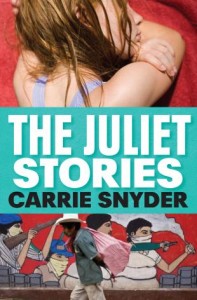
 The past few months have been the strongest literary season I’ve ever experienced, one brilliant book after another in a way that has renewed my faith in an industry that is broken in so many ways. There is this: good books get published. They find a way. (And also this: independent presses are doing extraordinary things.)
The past few months have been the strongest literary season I’ve ever experienced, one brilliant book after another in a way that has renewed my faith in an industry that is broken in so many ways. There is this: good books get published. They find a way. (And also this: independent presses are doing extraordinary things.)
Three of these good books in particular this spring have been Heather Birrell’s Mad Hope, Carrie Snyder’s The Juliet Stories, and Daniel Griffin’s Stopping for Strangers. And if their good books weren’t enough, now the universe has seen fit to bring all these fine writers together under one roof, Type Books’, for a reading on May 16, and even better, I get to host it. I’m excited, and also honoured. Looking forward to introducing Heather, Carrie and Daniel, and leading a discussion after their readings. Can you imagine better company that I could possibly keep?





